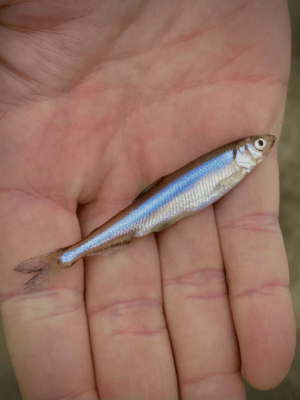Photo: Delta smelt are native to the Sacramento-San Joaquin Delta
Reclamation, partner agencies continue extraordinary effort to save Delta smelt
The group of low-slung, nondescript buildings in a remote corner of San Joaquin County near Tracy are hardly noticeable and are not open to the public.
Inside, scientists are cultivating a slender, silvery minnow-like fish species with the aim of staving off its extinction, and reverse the course of decline of the long-troubled Delta smelt.
Those familiar with the plight of the Sacramento-San Joaquin Delta need no introduction to the Delta smelt. Derided by some pundits as a worthless bait fish whose existence stymies water deliveries, the once-plentiful smelt’s tale is one of the estuary’s woes. Found nowhere else on the planet, its numbers have plummeted, an indication of the many changes in the Delta ecosystem that negatively affect native fishes.
This translucent fish lives in the open water of the Sacramento-San Joaquin Delta and completes its lifecycle in about a year. They hatch, mature and reproduce within the slightly salty to freshwaters of the Delta.
Since its listing by the Endangered Species Act 30 years ago, the Delta smelt has been the focus of an intense, comprehensive plan to protect the dwindling wild population, and in recent years to kick-start its recovery. Those years have been marked with barely perceptible advances that only protect against extinction, with occasionally noteworthy occurrences such as the release of thousands of fish via boat or tanker truck.
Such was the case on a recent winter morning as some 25,000 Delta smelt made the 50-mile trip via truck from the U.C. Davis Fish Conservation and Culture Laboratory near Tracy to the chilly, murky waters of the Sacramento River at Rio Vista. It’s the third year of the Experimental Release program, with each action adding to the trove of knowledge scientists have about the best way to supplement the much-depleted wild population of the fish.
“Every year that we do this we learn more and gain perspective on where and how we want to release the fish,” said Nick Bertrand, fish biologist with Reclamation’s Bay-Delta Office.
That includes discerning the difference between releasing fish in open water by boat or from shore via tanker truck, which is regarded as quicker and more efficient way to transport a greater number of fish.
Reclamation funds the work at […]
Full article: mavensnotebook.com

